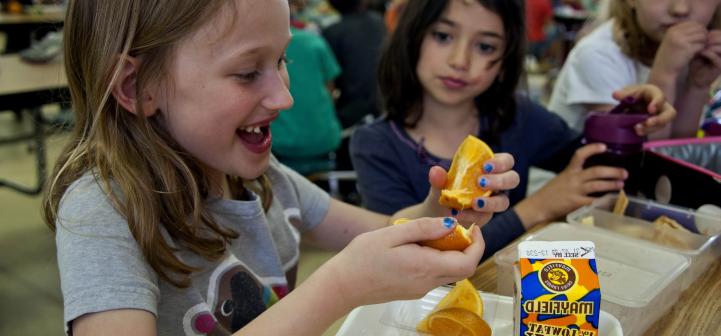
Cornell Cooperative Extension (CCE) of Jefferson County, Eat Smart New York (ESNY) and Watertown City School District partnered to provide monthly nutrition lessons, food demonstrations and food tastings based on the farm to school monthly harvest produce item to nearly 2,000 students in the district.
The Farm to School movement enriches the connection communities have with fresh, healthy food and local food producers by changing food purchasing and education practices at schools. However, more than just where the food is purchased needs to be addressed in a school to make an impact on the health and nutrition of students. Constant engagement – inside and outside the cafeteria – is key to students’ willingness to change their eating habits.
SNAP-Ed Nutrition Education provides interactive lessons that lead to behavior change such as increased consumption of vegetables and fruits. These lessons are important to promote optimal childhood health, growth and intellectual development, which is needed for children to reach their full academic potential.
The Smarter Lunchrooms Movement is dedicated to providing schools with the knowledge, motivation, and resources needed to build a lunchroom environment that makes healthy food choices the easy choice. The Movement brings evidence from the fields of economics, marketing, and psychology into the school cafeteria. Smarter Lunchrooms strategies are free or low-cost solutions that nudge students to voluntarily select the healthiest food in the lunchroom. Smarter Lunchrooms can help school nutrition services see less waste, higher participation, more satisfied students, and increased consumption of important nutrient-rich foods.[1]
Combining all three programs to maximize resources and impact is a win win for all involved. In the Watertown City School District, Cornell Cooperative Extension and Eat Smart New York educators developed a schedule to provide monthly education in each of the six elementary buildings in the district. They worked with school administrators and teachers to ensure there was enough time to provide a lesson in addition to a food tasting. The lessons are fast paced, interactive and engaging. Students are learning about the how’s and the why’s of nutrition. The food demonstration and tasting provide an opportunity to experience foods and recipes students likely have never tried before, and allow them to decide what they like and don’t like. They are encouraged to try the recipes at home with their families (and many report doing so) as well as choosing the produce items when they are available in the school cafeteria. The district’s new food service director is working to incorporate the harvest of the month produce item into the school menus. Over 75% of the students indicate through surveys that they intend to increase the amount of vegetables and fruits they consume at school. To help with this, the cafeteria is implementing Smarter Lunchroom strategies such as serving both hot and cold vegetables, having vegetables at many places on the serving line, and incorporating vegetables into entrees. Additional schools in the area are recognizing the positive impacts of these program partnerships and are beginning the planning and implementation process in their own school.
